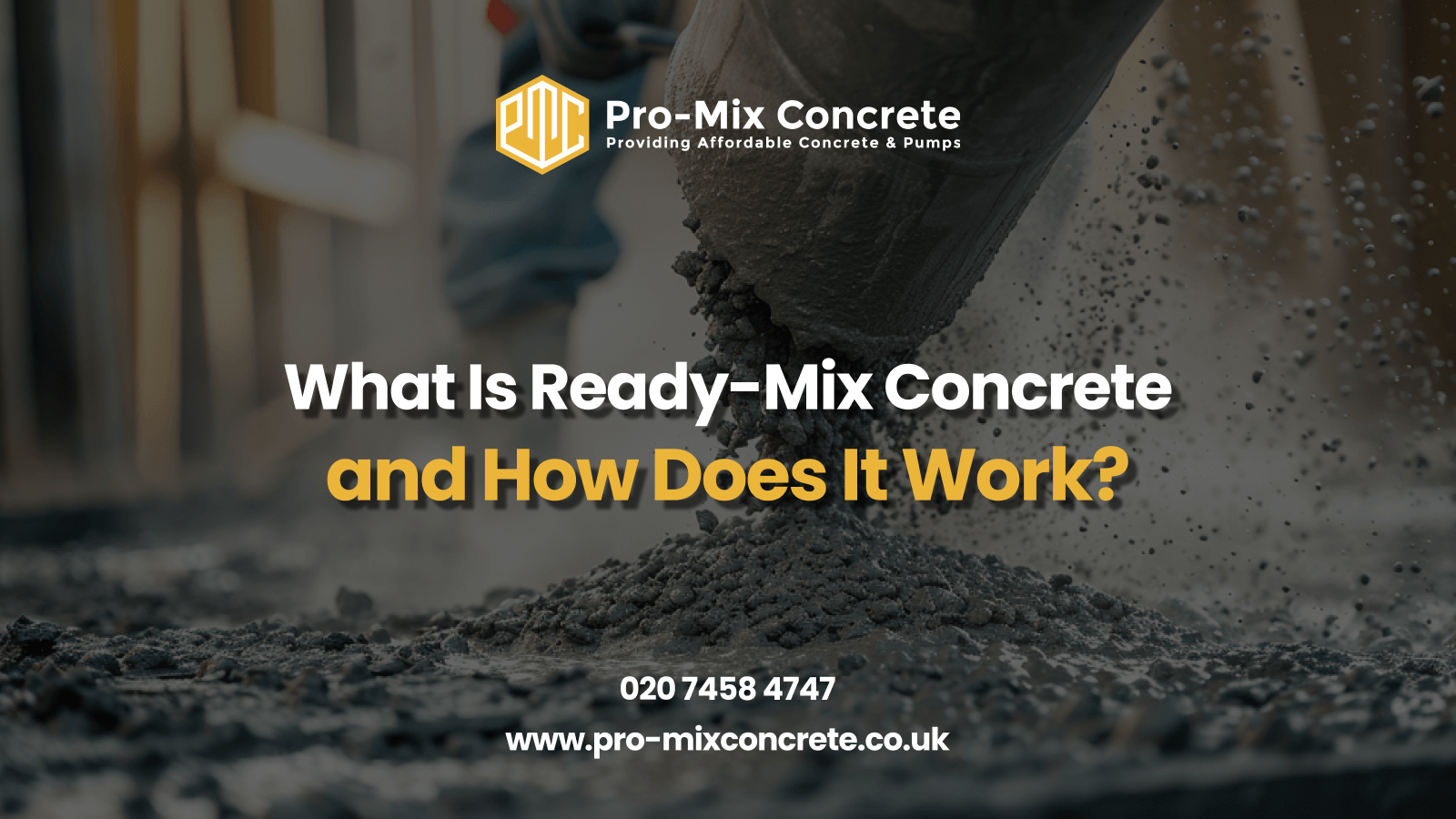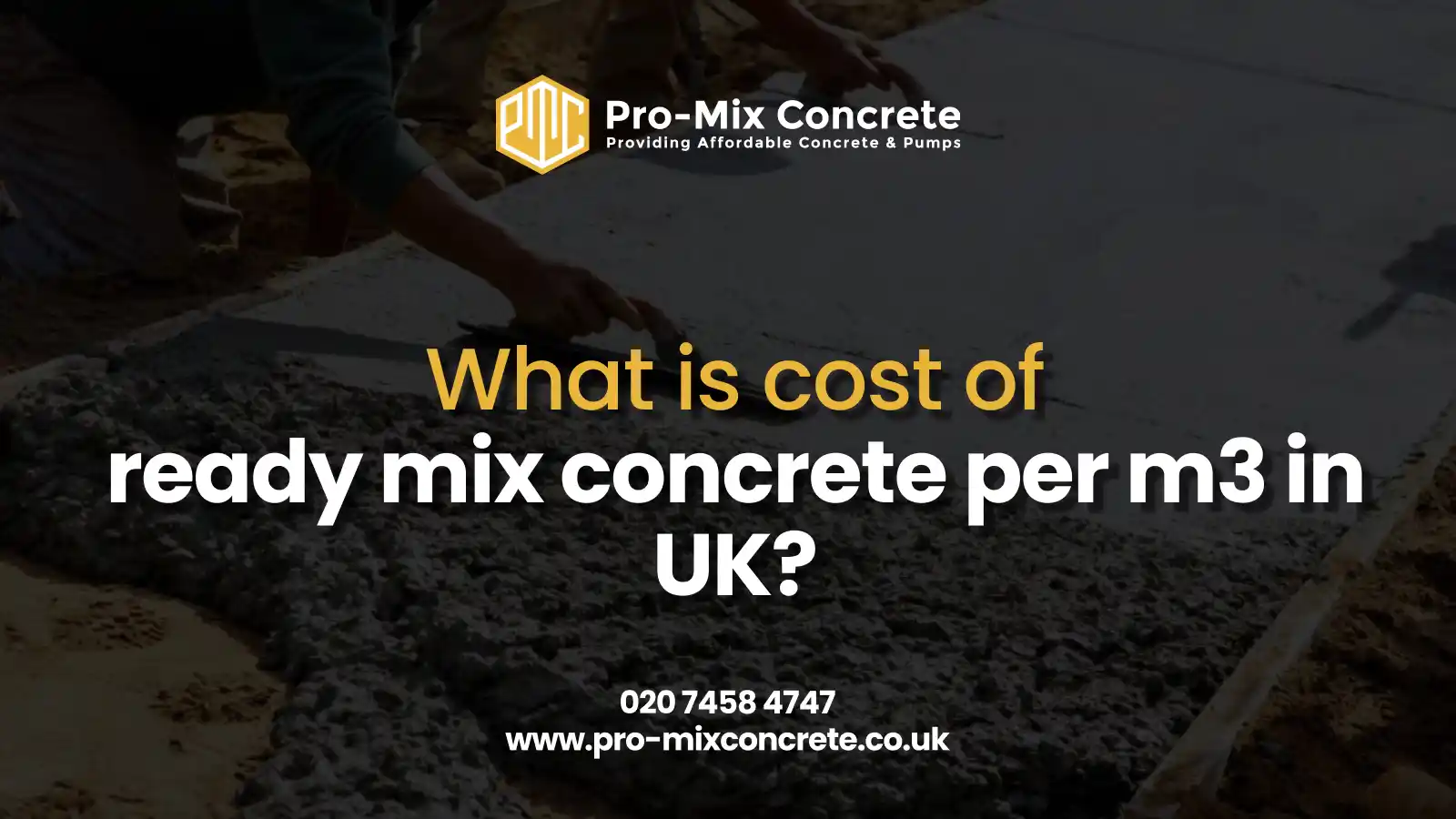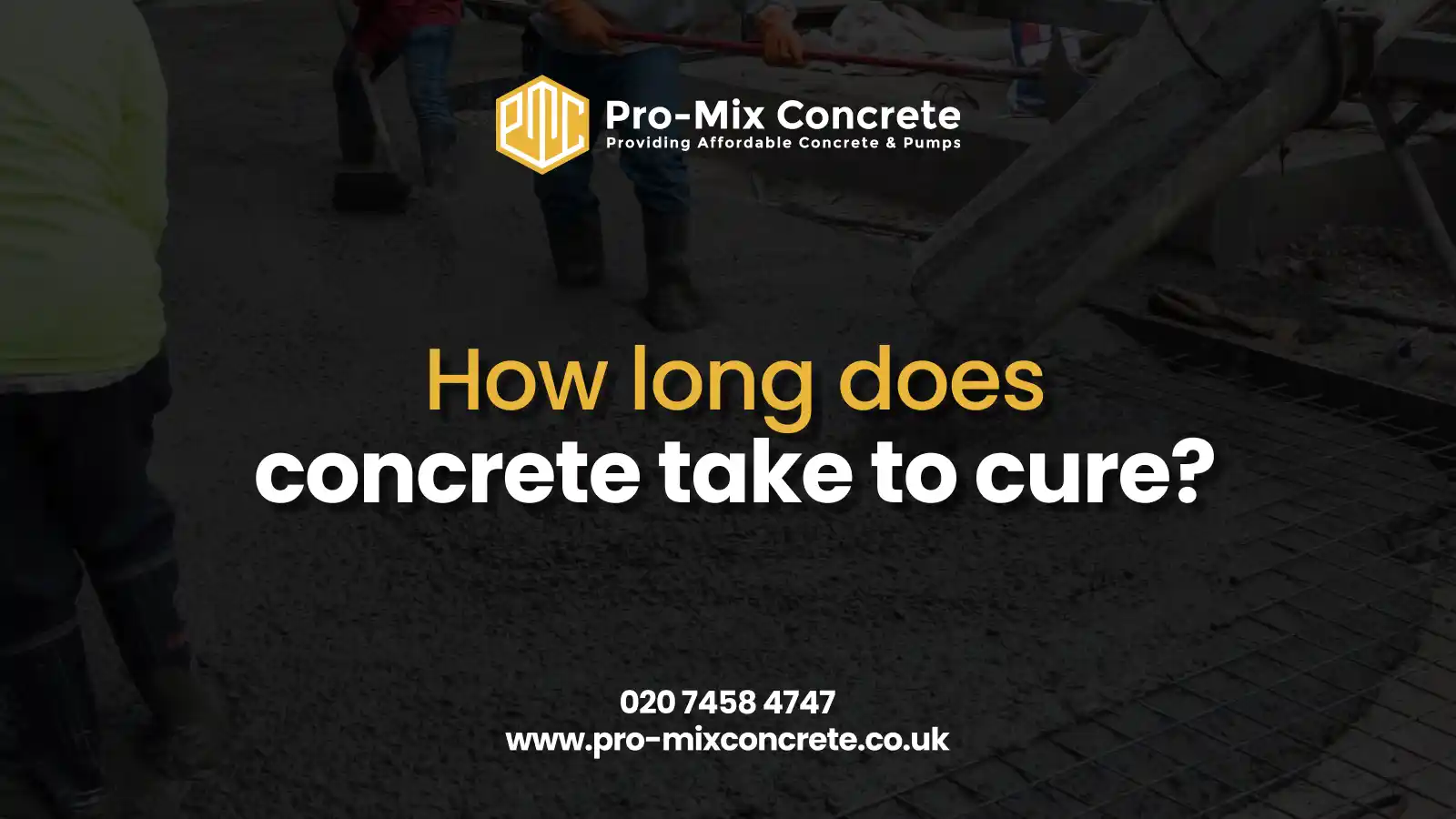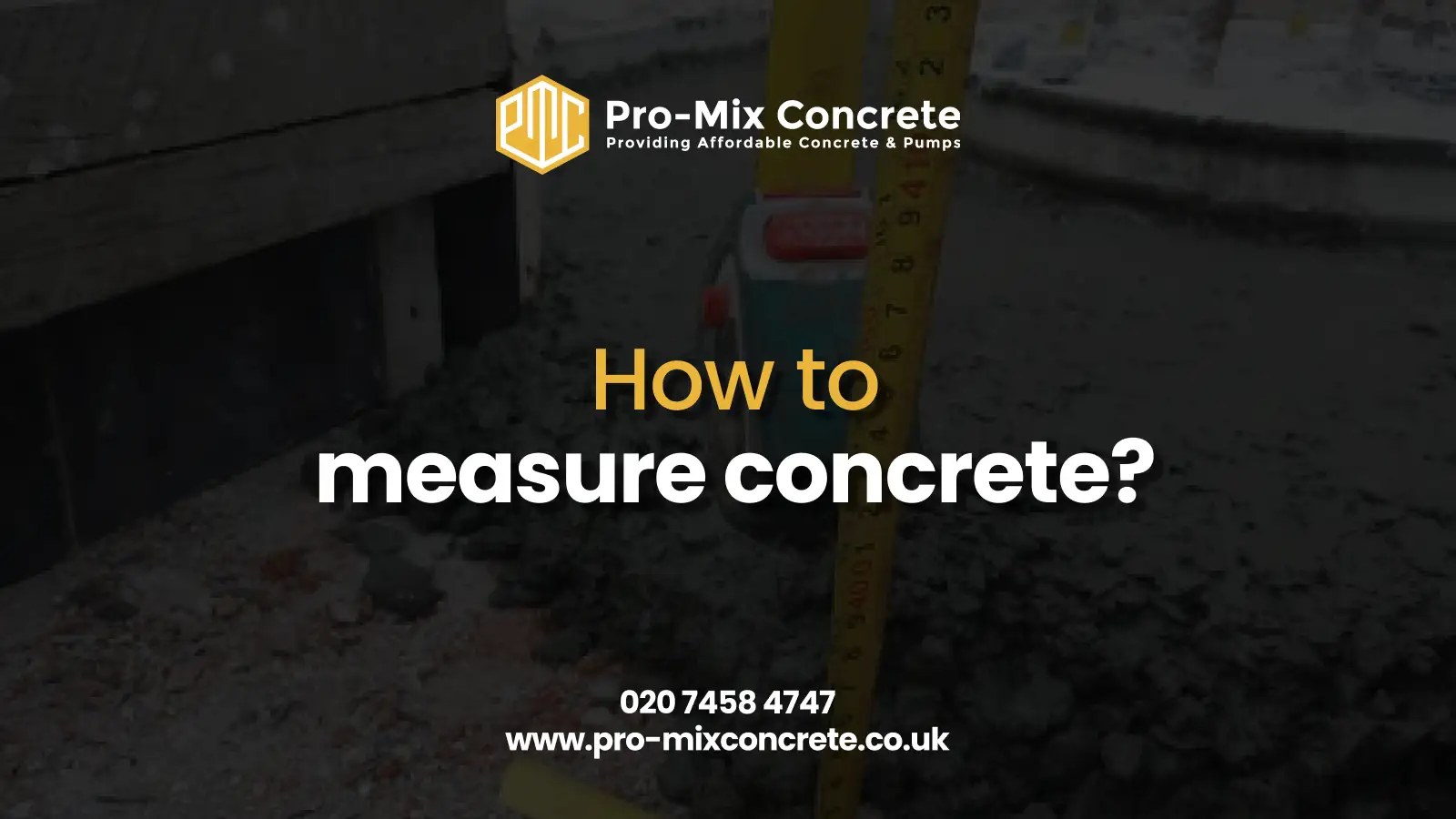What if your next construction project didn’t have to worry about mixing errors, wasted material, or delays on-site? That’s exactly why ready-mix concrete (RMC) is changing the game. It’s made in a controlled environment, delivered fresh to your location, and tailored for your project, whether you’re building a driveway or a high-rise. As cities grow and timelines shrink, the demand for RMC is skyrocketing. In fact, the global ready-mix concrete market was valued at USD 998.69 billion in 2024, and it’s projected to reach over USD 2 trillion by 2032, with a CAGR of 9.1%. Today, Ready Mix Concrete is a preferred choice in construction due to its consistent quality, cost-effectiveness, and reduced environmental impact.
What Is Ready-Mix Concrete?
Ready-mix concrete is a type of concrete that is pre-mixed at a batching plant according to a specific recipe and delivered to the construction site in a ready-to-use form. Unlike traditional concrete, which is mixed on-site, RMC is prepared in a central plant, ensuring consistent quality and accurate proportions. Once mixed, the concrete is delivered to the site in a specialised truck with a rotating drum, which keeps the concrete from setting until it’s ready to pour.
Key Components of Ready-Mix Concrete
The essential ingredients that make up ready-mix concrete include:
- Cement: Acts as the binder that holds everything together. The most commonly used cement is Portland cement, which reacts with water to harden and form concrete.
- Aggregates: These are inert materials like sand, gravel, or crushed stone. Fine aggregates (sand) fill the spaces between the larger aggregates, while coarse aggregates provide strength and stability.
- Water: Reacts with cement to start the hydration process, turning the dry mixture into a workable paste that binds the aggregates together.
- Admixtures: These are chemical additives that alter the properties of the concrete, such as its setting time, workability, or resistance to freezing. For example, accelerators speed up the curing time, while retarders slow it down.
How Ready-Mix Concrete Works
Ready-mix concrete works in a streamlined and highly controlled process, ensuring the highest quality mix arrives at the construction site.
1. Mixing Process at the Batching Plant
The mixing of the concrete happens at a centralised batching plant. Here, the raw materials (cement, aggregates, water, and admixtures) are carefully weighed and mixed according to precise formulas. Most plants are automated, so the mixing process is precise, reducing human error.
- Precision in Proportions: The raw materials are measured based on specific requirements, whether it’s for high-strength, fast-setting, or any other special mix. The consistency is ensured for each batch.
- Additives: Chemicals, such as accelerators or retarders, are added to adjust the concrete’s setting time or enhance its properties, like workability and durability.
2. Transportation to the Site
After mixing, the concrete is transported to the construction site in a rotating drum truck, also known as a concrete mixer truck. This ensures that the concrete doesn’t harden during transport.
- Rotating Drum: The drum keeps turning while the truck is en route to prevent the concrete from setting. This constant movement ensures the mixture remains uniform and workable upon arrival.
- Temperature Considerations: Concrete is sensitive to temperature, and the truck may use cooling systems or insulated covers to maintain the concrete’s temperature and prevent premature setting, especially in hot climates.
3. Pouring the Concrete
Once the ready-mix concrete arrives on-site, the crew prepares to pour it into moulds or forms. This step is quick and efficient, reducing downtime on the job site.
- Flexible Delivery: The rotating drum allows the concrete to be poured in multiple directions, reaching difficult or elevated areas without requiring additional equipment.
- Proper Handling: Concrete is poured carefully to avoid air pockets, which could weaken the structure. Vibrators are often used to ensure the concrete fills the form completely and without voids.
4. Curing the Concrete
After the concrete is poured, it needs time to cure and harden. Curing is a crucial process, as it ensures the concrete achieves its full strength and durability.
- Moisture Control: Concrete is kept moist for the first few days to avoid cracking due to rapid drying. Special curing blankets or sprays are used to retain moisture during the curing period.
- Time to Set: Concrete typically begins to set within hours, but it takes several days to fully cure. During this time, it gains strength, becoming capable of bearing loads and withstanding external forces.
5. Final Testing and Inspection
Before the project is considered complete, ready-mix concrete undergoes final testing and inspection to ensure it meets required standards.
- Strength Testing: Samples are taken from the batch to measure compressive strength. This helps to confirm that the concrete meets the necessary specifications for load-bearing and durability.
- Quality Control: The supplier typically conducts quality assurance tests to ensure each batch is uniform and meets project specifications.
Why Ready-Mix Concrete Is the Right Choice for Many Projects
Ready-mix concrete offers several advantages that make it an ideal choice for various construction projects. It’s cost-effective, time-saving, and provides consistent, high-quality results. Here’s why ready-mix concrete is often the preferred choice:
1. Time and Labour Efficiency
One of the biggest benefits of using ready-mix concrete is the time saved during the construction process.
- Reduced Setup Time: There’s no need to set up mixers or organise raw materials on-site with ready-mix concrete. This means contractors can focus on other aspects of the project, reducing the overall time spent on preparation.
- Faster Pouring Process: Concrete arrives pre-mixed and ready to use, making it easier and faster to pour. This speeds up the construction timeline and allows workers to move on to other tasks sooner.
2. Consistency and Quality Control
The most critical aspect of construction is ensuring that materials are uniform and high quality. With ready-mix concrete, you’re guaranteed a consistent product every time.
- Precision Mixing: At a batching plant, ingredients are measured precisely, so each batch meets the exact specifications required. This eliminates the possibility of inconsistencies in the mix, which is common with on-site mixing.
- Quality Assurance: Most batching plants follow strict quality control standards and perform tests to ensure that the concrete meets the necessary strength, durability, and workability criteria.
3. Cost-Effectiveness
Though the initial cost of ready-mix concrete might be higher than mixing concrete on-site, the overall cost can be lower due to reduced labour, time, and material wastage.
- Reduced Waste: Since the concrete is prepared in specific quantities, there’s no risk of leftover material being wasted. Ordering the exact amount needed ensures that no material goes unused.
- Labour Savings: Fewer workers are needed on-site for mixing, which reduces labour costs and improves efficiency.
4. Convenience
The convenience of ready-mix concrete is one of its strongest selling points. There’s no need to deal with the hassle of raw materials, equipment, or mixing on-site.
- No Need for On-Site Storage: With ready-mix concrete, you don’t need to store cement, aggregates, or other raw materials on the construction site. This saves space and keeps the site organised.
- Immediate Availability: Concrete is delivered exactly when it’s needed, reducing downtime and allowing construction to proceed uninterrupted.
Different Applications of Ready-Mix Concrete
Ready-mix concrete can be used for a wide range of projects, from small residential jobs to massive infrastructure developments. Here are some of the most common applications for RMC:
Residential Projects
Ready-mix concrete is a popular choice for residential construction, offering durability and strength for various applications.
- Driveways and Pavements: Ready-mix concrete provides a sturdy and long-lasting surface, perfect for driveways and sidewalks that can withstand vehicle traffic and weather elements.
- Foundations: Ready-mix concrete is often used for the foundations of homes, providing a strong, stable base for the structure. Its consistency ensures a smooth and even pour.
In residential projects, ready-mix concrete offers a simple, hassle-free solution, particularly when pouring foundations or creating other concrete surfaces like patios or walkways.
Commercial Projects
Commercial projects, from office buildings to shopping malls, require a type of concrete that can support significant weight and remain durable over time. Ready-mix concrete fits the bill perfectly.
- High-Strength Concrete: Ready-mix concrete can be formulated to meet higher strength requirements, making it ideal for large commercial structures.
- Paving for Roads: Roads and highways require robust concrete to withstand traffic load, extreme weather conditions, and daily wear and tear. Ready-mix concrete provides the strength and durability needed for such projects.
Ready-mix concrete offers contractors a quick and reliable solution for large-scale commercial projects that demand consistent, high-quality concrete.
Infrastructure Projects
Infrastructure projects, including bridges, dams, and tunnels, benefit significantly from ready-mix concrete due to its ability to meet high strength and durability requirements.
- Bridges and Overpasses: Ready-mix concrete is essential in creating bridges and overpasses that can handle high traffic loads and withstand environmental factors like corrosion and extreme weather.
- Dams and Reservoirs: Ready-mix concrete is often used in dam construction for its ability to resist water pressure and prevent erosion, ensuring that these large structures remain safe and functional over time.
The precision and high-strength formulations of ready-mix concrete are crucial in the construction of major infrastructure projects that demand longevity and resilience.
Different Types of Ready-Mix Concrete
There are several types of ready-mix concrete, each designed for different construction needs. Understanding the differences between these types will help you choose the right one for your project.
Type of Concrete | Description |
Normal Strength Concrete | The most commonly used type of concrete is for general construction tasks like foundations, driveways, and sidewalks. |
High-Strength Concrete | Designed for projects that need to support heavy loads, such as skyscrapers, bridges, or industrial structures. |
Lightweight Concrete | Made with lightweight aggregates, reducing the density of the concrete. Ideal for projects where minimising weight is critical, such as precast panels or roof decks. |
Self-Consolidating Concrete (SCC) | A highly fluid mix that doesn’t need mechanical vibration to fill complex moulds or forms. Ideal for projects with intricate designs and heavy reinforcement. |
Decorative Concrete | Used for aesthetic purposes, such as patios, driveways, or floors. Can be stamped, coloured, or textured for decorative appeal. |
How to Choose the Right Type of Ready-Mix Concrete
When selecting the right type of ready-mix concrete for your project, consider the following:
- Project Type: What is the concrete being used for? Residential, commercial, or infrastructure? The type of project dictates the strength and formulation you need.
- Environmental Conditions: Concrete exposed to extreme temperatures, high moisture, or chemicals may need special admixtures or higher strength formulations.
- Load-Bearing Requirements: High-load projects, such as bridges or high-rise buildings, require stronger concrete that can withstand the pressure.
Selecting the right type ensures that your concrete performs optimally, providing durability, safety, and aesthetic appeal.
How to Order Ready-Mix Concrete
Ordering ready-mix concrete is a simple process, but it’s important to follow certain steps to ensure you get the right amount and mix for your project.
1. Calculate the Quantity Needed
Before placing an order, accurately calculate the amount of concrete required for the project. You can use online calculators or consult with a supplier to determine how much concrete you’ll need.
2. Select the Right Mix
Choose the appropriate mix based on the project’s requirements. Different projects may require different strength levels, aggregate sizes, or additional additives to enhance performance.
3. Place the Order
Once you have the quantity and mix, contact a local ready-mix supplier to place your order. Provide details about the project, such as the delivery address, the time frame for pouring, and any special requests (e.g., additives or additives).
4. Prepare for Delivery
Ensure that the construction site is ready for the delivery of concrete. Prepare the area for easy access, and have the necessary tools on hand for pouring the concrete into molds or foundations.
Challenges in Using Ready-Mix Concrete
While ready-mix concrete offers many benefits, there are a few challenges to keep in mind.
1. Delivery Delays
Delivery can be delayed due to various factors, such as traffic or issues at the batching plant. Plan ahead to ensure that delays won’t cause interruptions to your project.
2. Premature Setting
If the concrete is not used quickly enough, it can begin to set in the delivery truck. This is particularly a risk in hot weather, so ensure that the concrete is poured promptly.
3. Mix Inconsistencies
Occasionally, the mix may not meet the required specifications, resulting in weak or flawed concrete. However, this risk is minimised with reputable suppliers who follow strict quality control measures.
Your Concrete, Your Project
Ready-mix concrete is an essential material in modern construction. Its efficiency, quality, and convenience make it the preferred choice for many types of projects, from residential to large infrastructure developments. Understanding how ready-mix concrete works, its benefits, and how to choose the right type for your needs can help ensure that your construction project goes smoothly and results in durable, long-lasting structures. By carefully selecting the right supplier and following best practices for ordering and using ready-mix concrete, you can save time, money, and effort while achieving excellent results.
Tired of concrete that cracks under pressure?
Pro-Mix Concrete doesn’t cut corners or make you wait. We show up ready to work, just like you. Every batch is precisely mixed for strength, speed, and zero surprises. No mess-ups. No wasted hours. Just rock-solid results that hold up, rain or shine. When the job can’t afford mistakes, Pro-Mix is the difference between getting it done and getting it done right.
Frequently Asked Questions
It saves time by eliminating on-site mixing, provides a precise mix tailored to your project, reduces labour costs, minimizes material waste, and improves overall construction quality.
Common types include standard concrete for general use, high-strength concrete for heavy-duty structures, self-compacting concrete that flows easily without vibration, and fibre-reinforced concrete for improved durability.
Concrete typically reaches its initial set within a few hours, but full curing to achieve design strength usually takes about 28 days. Proper curing conditions are essential to ensure durability.
While possible, it is generally recommended to have professional assistance because proper mixing, pouring, finishing, and curing techniques are critical for quality results.
Although the upfront cost may be higher, ready mix concrete reduces labour, storage, and waste costs, often making it more economical overall.
- Dennis Broderick
- Dennis Broderick is the founder and owner of Pro-Mix Concrete Company, a trusted name in ready-mix concrete solutions across the UK. With over 20 years of hands-on experience in the construction and concrete industry, Dennis brings unmatched expertise, practical insights, and a commitment to quality on every project - from residential driveways to large-scale commercial developments.
 BlogNovember 26, 2025Ready Mix Concrete Costs UK: 7 Key Factors That Affect Your Price Per m³
BlogNovember 26, 2025Ready Mix Concrete Costs UK: 7 Key Factors That Affect Your Price Per m³ BlogNovember 26, 2025How Long Does Concrete Take To Cure?
BlogNovember 26, 2025How Long Does Concrete Take To Cure? BlogNovember 20, 2025How To Measure Concrete With A Concrete Calculator?
BlogNovember 20, 2025How To Measure Concrete With A Concrete Calculator? BlogNovember 15, 2025What is the Mix Proportion of Concrete?
BlogNovember 15, 2025What is the Mix Proportion of Concrete?





